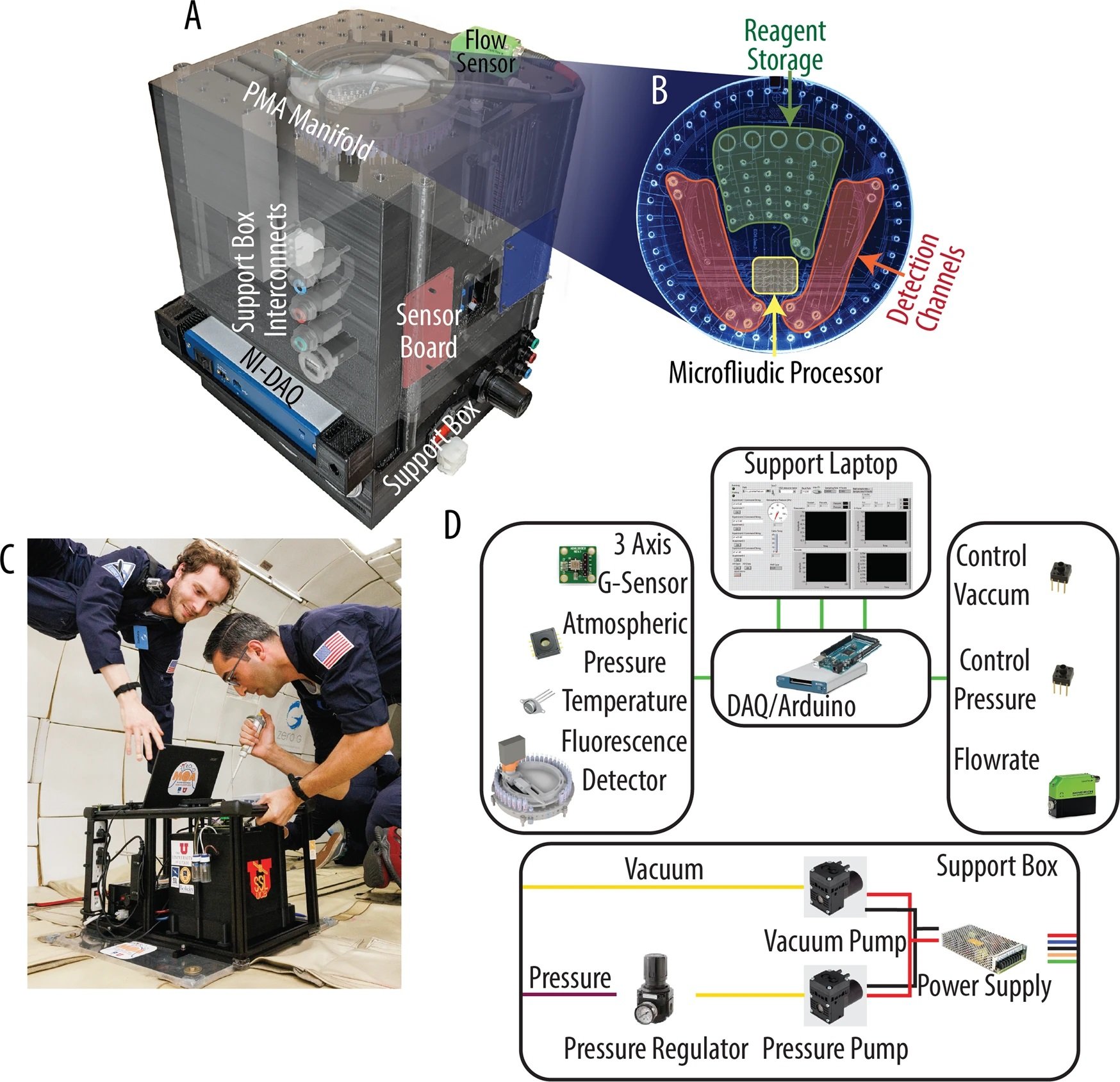
19 Jun Exploring Microfluidics in Space: Testing a Programmable Microfluidic Analyzer in Microgravity
Space exploration has always been a realm of limitless possibilities and scientific discovery. In the quest to unravel the mysteries of the universe and seek signs of life beyond Earth, innovative technologies continue to play a crucial role. One such breakthrough lies in the field of microfluidics, where a programmable microfluidic organic analyzer (MOA) has demonstrated exceptional functionality even under simulated microgravity conditions.
“This work examines how the programmable microfluidic analyzer performed under simulated Lunar, Martian, zero, and hypergravity conditions during a parabolic flight. We confirmed that the functionality of the programmable microfluidic analyzer was minimally affected by the significant changes in the gravitational field, thus paving the way for its use in a variety of space mission opportunities. “, the authors explained.
Microfluidics, the manipulation of minute amounts of fluids at the micro- to nano-liter scale, offers immense potential in space exploration due to the ability of the microfluidic chips to perform highly sensitive chemical and biological analyses. The MOA represents a significant advancement in microfluidic technology, combining a programmable microvalve array (PMA) and a laser-induced fluorescence (LIF) detection system. This state-of-the-art microfluidic device is microfabricated using conventional soft lithography methods, which involve the microfabrication of microfluidic and pneumatic layers using polydimethylsiloxane (PDMS). The layers are bonded together through oxygen plasma treatment, creating a seamless microfluidic platform.
The heart of the MOA is the programmable microvalve array (PMA), a fully addressable pneumatic microfluidic valve array that enables precise control over sample preparation and manipulation steps. These microvalves function like a conventional logic circuit, allowing for switching between different states to direct the flow of fluids. By applying vacuum or pressure, the microvalves can open or close, facilitating the movement of liquids within the microchannels.
To validate the functionality of the microfluidic device under different gravitational environments, a team of researchers conducted a series of experiments during a parabolic flight simulating Lunar, Martian, zero, and hypergravity conditions. During the parabolic flight, the MOA underwent several assessments to evaluate its capabilities. Flowrate measurements were conducted to ensure consistent and accurate pumping performance under different gravitational conditions. The mixing and metering accuracy of the PMA were also tested, showcasing the MOA’s ability to dilute fluorophores to specific concentrations reliably. The LIF detection system complemented the MOA’s functionality by providing precise measurements, independent of the gravitational environment. The results were truly groundbreaking. Despite the significant changes in gravitational forces, the MOA exhibited minimal performance impact, reaffirming its suitability for space missions and clinical monitoring of astronaut health.
The experiments involved various assessments of the MOA’s capabilities, including flowrate measurement and dilution accuracy. The PMA, responsible for fluidic processing and control, demonstrated consistent and accurate pumping performance across different gravitational conditions. The mixing and metering accuracy of the PMA were also evaluated, showing remarkable results in diluting fluorophores to specific concentrations. The LIF detection system complemented the MOA’s functionality by providing precise and reliable measurements, regardless of the gravitational environment.

“A View of the main instrument indicating the internal component placement, including the sensor board, flowrate sensor, and NI DAQ used to obtain the environmental and experimental information. B PMA-µCE chip was tested with labeled sections: reagent storage for incubating and storing chemicals during analysis, the microfluidic processor that handles fluid delivery around the chip, and the detection channels where fluorescent dyes are pulled through LIF for measurement. C In-flight view of the testing apparatus being operated and monitored during microgravity exposure. Both individuals in the image have consented to their use. D System diagram for the sensors, control, and support equipment.” Reproduced from Estlack, Z., Golozar, M., Butterworth, A.L. et al. Operation of a programmable microfluidic organic analyzer under microgravity conditions simulating space flight environments. npj Microgravity 9, 41 (2023). under Creative Commons Attribution 4.0 International License.
These findings open up a multitude of possibilities for space exploration. The MOA’s resilience to changes in gravitational forces highlights its potential for detecting organic biosignatures of extraterrestrial life. The ability to gather and analyze samples from celestial bodies like Enceladus and Europa could provide invaluable insights into the existence of life beyond our planet.
Furthermore, the MOA holds promise as a tool for monitoring astronaut health during space missions. Its compact design, reconfigurability, and power-efficiency make it an ideal candidate for analyzing biomarkers and conducting clinical assays in microgravity environments. This advancement in space medical research could greatly contribute to ensuring the well-being of astronauts during prolonged space missions.
“The MOA platform is being updated based on the lessons learned from the flight, including the implementation of LED indicators to monitor experimental status, the addition of high voltage circuits for µCE, and the modification of the current layout to improve accessibility so that it can serve as a robust and reliable platform for future microgravity experiments and additional fieldwork. The outcomes of this and our future flights will demonstrate the capability of MOA for a variety of space missions, including crew health monitoring platforms as well as the search for signs of extra-terrestrial life. “, the authors explained.
Figures are reproduced from McCully, A.L., Loop Yao, M., Brower, K.K. et al. Double emulsions as a high-throughput enrichment and isolation platform for slower-growing microbes. ISME COMMUN. 3, 47 (2023). https://doi.org/10.1038/s43705-023-00241-9 under Creative Commons Attribution 4.0 International License.
Read the original article: Operation of a programmable microfluidic organic analyzer under microgravity conditions simulating space flight environments


